Anyone who has their head screwed on straight is now likely really afraid of inflation. And soaring Treasury yields clearly reflect that fear.

The US consumer price index for March rose 8.5% on the year, though optimists looking at the so-called “core” inflation rate noted it came in under forecasts at 0.3%, suggesting to them that inflation may have peaked.
No such luck.
The producer price index released last week increased a whopping 11.2%. These are wholesale prices that feed into retail prices. The PPI indicates that consumer prices will continue to rise.
Yield on the 10-year Treasury note soared Monday to above 2.88% at one point after a three-day holiday weekend. It fell back in late trading but still showed a gain of nearly 5 basis points on the day.

The increase in the 10-year yield is outpacing the 2-year yield, widening the spread between the two and unsettling technical analysts who see a resistance in the 30-40 bps range as they worry what it means if the yield curve widens beyond that level.
Yield on the two-year Treasury note was above 2.45% in late trading Monday, a gain of just above 1 bp on the day and a widening gap could signal a loss of confidence that the Fed will be able to curb inflation in the longer run.
In a low-inflation environment, economists—and consumers—could ignore PPI and fluctuations in food and energy prices contained in the headline rate that were stripped out in the “core” rate.
But surging prices in oil, gas, food, and other commodities are now driving price increases across the board and shifting consumer expectations.
Bonds Don't Lie...Inflation Hasn't Peaked
The government, the Fed, Wall Street, and much of the financial media have a vested interest in gaslighting this reality. But the bond market does not lie, even if some investors may be temporarily misled by optimistic analysis. In this environment, money is on the line.
Less than a month ago, Goldman Sachs forecast yield on the 10-year Treasury note could reach 2.7% by the end of this year. It has, of course, surged above that mark in the past week.
Mohamed El-Erian, the former PIMCO CEO who is now chief economist for Allianz, says inflation has not peaked and the Fed may have to raise its target from 2% to avoid shredding its credibility. Raising the target to 3%, however, would be “incredibly controversial,” according to this expert.
Europe observed the Easter Monday holiday yesterday, but investors were still flummoxed by the European Central Bank’s decision last week to hold off on setting a date for rolling back monetary stimulus even though the latest inflation reading in the eurozone was 7.5%.

Investors bought EU government bonds, lowering yields. Yield on Germany’s benchmark 10-year bond slipped to below 0.77% after the announcement.
However, Otmar Issing, the ECB’s first chief economist and a founder of the euro currency, blasted the decision and accused the central bank of having “lived in a fantasy” as it ignored the onset of inflation.
Issing, a former official at Germany’s Bundesbank, was expressing his country’s aversion to inflation in no uncertain terms. In an interview with the Financial Times, he said:
“Inflation was a sleeping dragon; this dragon has now awoken.”
